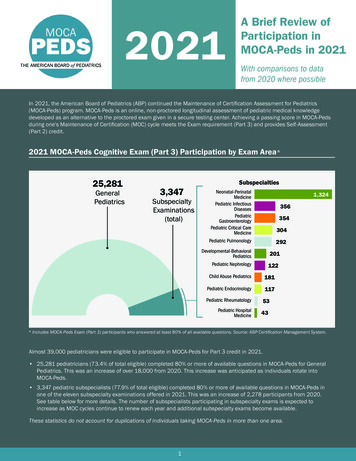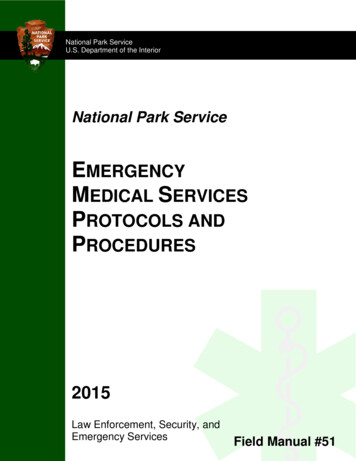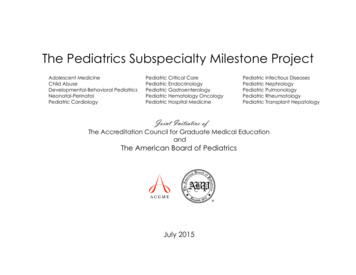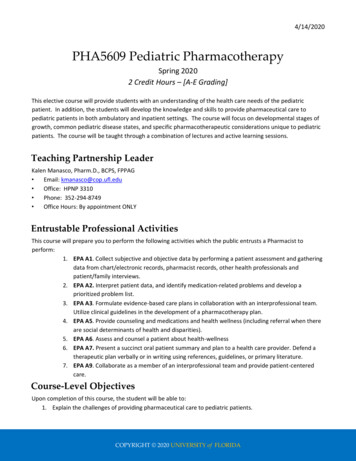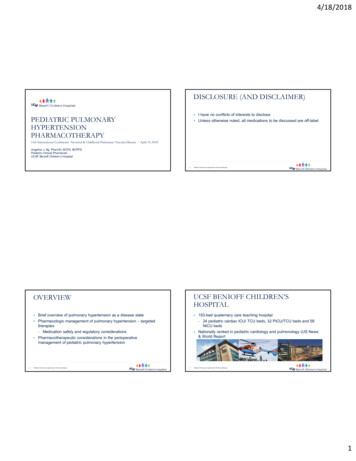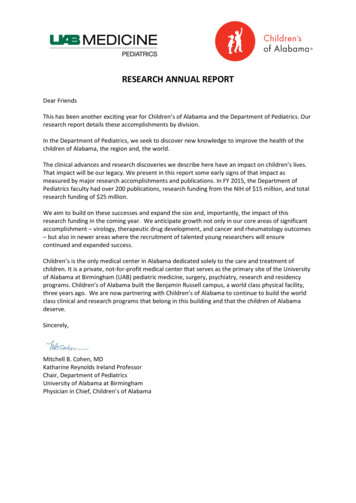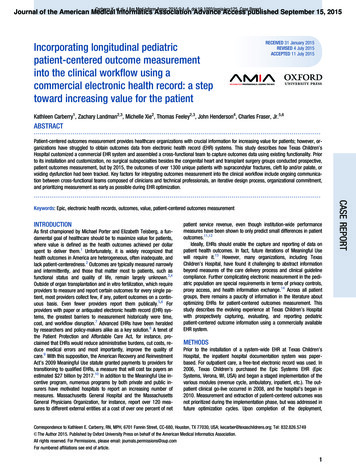
Transcription
Carberry K, et al. J Am Med Inform Assoc 2015;0:1–6. doi:10.1093/jamia/ocv125, Case ReportJournal of the American MedicalInformatics Association Advance Access published September 15, 2015Incorporating longitudinal pediatricpatient-centered outcome measurementinto the clinical workflow using acommercial electronic health record: a steptoward increasing value for the patientRECEIVED 31 January 2015REVISED 4 July 2015ACCEPTED 11 July 2015Kathleen Carberry1, Zachary Landman2,3, Michelle Xie2, Thomas Feeley2,3, John Henderson4, Charles Fraser, Jr.5,6ABSTRACT.Patient-centered outcomes measurement provides healthcare organizations with crucial information for increasing value for patients; however, organizations have struggled to obtain outcomes data from electronic health record (EHR) systems. This study describes how Texas Children’sHospital customized a commercial EHR system and assembled a cross-functional team to capture outcomes data using existing functionality. Priorto its installation and customization, no surgical subspecialties besides the congenital heart and transplant surgery groups conducted prospective,patient outcomes measurement, but by 2015, the outcomes of over 1300 unique patients with supracondylar fractures, cleft lip and/or palate, orvoiding dysfunction had been tracked. Key factors for integrating outcomes measurement into the clinical workflow include ongoing communication between cross-functional teams composed of clinicians and technical professionals, an iterative design process, organizational commitment,and prioritizing measurement as early as possible during EHR optimization.INTRODUCTIONAs first championed by Michael Porter and Elizabeth Teisberg, a fundamental goal of healthcare should be to maximize value for patients,where value is defined as the health outcomes achieved per dollarspent to deliver them.1 Unfortunately, it is widely recognized thathealth outcomes in America are heterogeneous, often inadequate, andlack patient-centeredness.2 Outcomes are typically measured narrowlyand intermittently, and those that matter most to patients, such asfunctional status and quality of life, remain largely unknown.3,4Outside of organ transplantation and in vitro fertilization, which requireproviders to measure and report certain outcomes for every single patient, most providers collect few, if any, patient outcomes on a continuous basis. Even fewer providers report them publically.5,6 Forproviders with paper or antiquated electronic health record (EHR) systems, the greatest barriers to measurement historically were time,cost, and workflow disruption.7 Advanced EHRs have been heraldedby researchers and policy-makers alike as a key solution.8 A tenet ofthe Patient Protection and Affordable Care Act, for instance, proclaimed that EHRs would reduce administrative burdens, cut costs, reduce medical errors and most importantly, improve the quality ofcare.9 With this supposition, the American Recovery and ReinvestmentAct’s 2009 Meaningful Use statute granted payments to providers fortransitioning to qualified EHRs, a measure that will cost tax payers anestimated 27 billion by 2017.10 In addition to the Meaningful Use incentive program, numerous programs by both private and public insurers have motivated hospitals to report an increasing number ofmeasures. Massachusetts General Hospital and the MassachusettsGeneral Physicians Organization, for instance, report over 120 measures to different external entities at a cost of over one percent of netpatient service revenue, even though institution-wide performancemeasures have been shown to only predict small differences in patientoutcomes.11,12Ideally, EHRs should enable the capture and reporting of data onpatient health outcomes. In fact, future iterations of Meaningful Usewill require it.13 However, many organizations, including TexasChildren’s Hospital, have found it challenging to abstract informationbeyond measures of the care delivery process and clinical guidelinecompliance. Further complicating electronic measurement in the pediatric population are special requirements in terms of privacy controls,proxy access, and health information exchange.14 Across all patientgroups, there remains a paucity of information in the literature aboutoptimizing EHRs for patient-centered outcomes measurement. Thisstudy describes the evolving experience at Texas Children’s Hospitalwith prospectively capturing, evaluating, and reporting pediatricpatient-centered outcome information using a commercially availableEHR system.METHODSPrior to the installation of a system-wide EHR at Texas Children’sHospital, the inpatient hospital documentation system was paperbased. For outpatient care, a free-text electronic record was used. In2006, Texas Children’s purchased the Epic Systems EHR (EpicSystems, Verona, WI, USA) and began a staged implementation of thevarious modules (revenue cycle, ambulatory, inpatient, etc.). The outpatient clinical go-live occurred in 2008, and the hospital’s began in2010. Measurement and extraction of patient-centered outcomes wasnot prioritized during the implementation phase, but was addressed infuture optimization cycles. Upon completion of the deployment,Correspondence to Kathleen E. Carberry, RN, MPH, 6701 Fannin Street, CC-680, Houston, TX 77030, USA; kecarber@texaschildrens.org; Tel: 832.826.5749C The Author 2015. Published by Oxford University Press on behalf of the American Medical Informatics Association.VAll rights reserved. For Permissions, please email: journals.permissions@oup.comFor numbered affiliations see end of article.1CASE REPORTKeywords: Epic, electronic health records, outcomes, value, patient-centered outcomes measurement
Carberry K, et al. J Am Med Inform Assoc 2015;0:1–6. doi:10.1093/jamia/ocv125, Case ReportCASE REPORTclinicians from multiple departments began requesting the ability tobetter measure meaningful patient outcomes, something theCongenital Heart Surgery Service at Texas Children’s Hospital HeartCenter was already doing with a homegrown software tool. Modeledafter this experience, a team of clinical data specialists, statisticians,data analysts, and systems analysts was assembled in December2011 and charged with incorporating patient-centered outcome measurement into the clinical workflow to enable meaningful measurement of every patient, beginning with selected conditions inorthopedic surgery, plastic surgery, and urology. By December 2013,the outcome measurement team included a dedicated vendor-trainedanalyst to build custom forms and to ensure that data capturedthroughout the care cycle (inpatient, outpatient, patient portal) couldbe aggregated and analyzed cumulatively.The decisions regarding which specialties were prioritized weremade at the level of the department of Surgery, and its subsidiary, theOutcomes & Impact Service. A key factor in prioritizing which departments would develop the tools first was an assessment of divisionalreadiness and the identification of a physician-champion. Custom toolsthat collected discrete and mineable data were first created for supracondylar fracture patients. Prior to their development, providers couldonly track supracondylar fracture patients using claims data, whichaggregated multiple types of fracture patterns together (type I, II, andIII) that have highly variable treatments and outcomes. A structuredand mineable spreadsheet for documenting patient care was developed to measure critical aspects of the patient presentation in theemergency center, such as mechanism of injury, hand color, and skincondition (Figure 1a). Similar but separate spreadsheets were used todocument the patient’s preoperative condition (Figure 1b), operativeexperience (Figure 1c), and condition upon discharge (Figure 1d).Clinicians used the forms at the point of care to document the patientassessment longitudinally. The development of each spreadsheet required structured dialogues regarding the timing and mode of datacapture among the orthopedic surgeons and the vendor-trained analyst building the spreadsheet.Following the development of supracondylar fracture patientspreadsheets, a more sophisticated data collection form was developed to capture outcomes for patients with voiding dysfunction that allowed for discrete data capture, prose note generation, imageincorporation, and the potential for clinical decision support.15 Theform was designed to assess and aggregate patient burden of diseasethrough patient-reported responses to assessments of both bladderand bowel function, pain, and quality of life using a validated tool(Figure 2).16 Midlevel practitioners used the form as part of their initialpatient intake and for ongoing assessment of disease burden, as theform automatically calculated and reported a disease-burden score ateach encounter. Clinicians and patients together referenced the scoresfrom prior visits and used the functional assessment information toguide interventions and escalations of care, such as initiation of antibiotic prophylaxis, biofeedback exercise, or behavioral therapy.In plastic and reconstructive surgery, structured spreadsheetswere initially created to capture patients’ functional and aestheticFigure 1: Emergency department history and physical documentation flowsheet: supracondylar fracture patient (imageprinted with permissions from Texas Children’s Hospital). (A) Fields from the initial evaluation portion of the flowsheet. (B)Fields from the preoperative evaluation portion of the flowsheet. (C) Fields from the operative experience portion of theflowsheet. (D) Fields from the condition at discharge portion of the flowsheet.2
Carberry K, et al. J Am Med Inform Assoc 2015;0:1–6. doi:10.1093/jamia/ocv125, Case ReportFigure 2: Form for evaluation of patient with voiding dysfunction (image printed with permissions from Texas Children’sHospital.).RESULTSPrior to the installation and optimization of the EHR, manual chartabstraction was the only means of measuring and reporting patientcentered outcomes. Other than the congenital heart surgery groups,which used dedicated, separate data capturing systems, no specialtiesconducted prospective, continuous measurement of patient outcomes.By 2014, more than two dozen mineable measures including pain,functionality, appearance, and burden of disease were being collectedon an ongoing basis in a structured format for three conditions:supracondylar fractures, cleft lip and palate, and voiding dysfunction(Table 1). While these conditions represented only a portion of eachdepartment’s total annual volume, over 1300 unique patients hadbeen tracked as of January 1, 2015. Data was being gathered in operating room, ambulatory, and Emergency Center settings.DISCUSSIONTo truly improve the quality of care and ultimately deliver value to thepatient, patient outcomes must be routinely measured and reported atthe level of the medical condition. Increasingly, this entails use of anelectronic health record. There are limited reports in the literatureabout how to integrate patient-centered outcomes measurement intothe EHR.19,20 This is the first study to systematically describe severalsuccessful approaches to incorporating pediatric patient-centered outcome measurement into a pre-existing commercially available electronic health record system leveraging existing functionality.21At the department level, incorporating patient-centered measurement tools such as structured forms and spreadsheets into the clinicalworkflow is an iterative process and requires a clinician-focused strategy and cross-functional teams consisting of front-line clinicians, vendor-trained analysts, data architects, and data specialists. Clinicianengagement is critical since providers directly interface with patientsand understand outcome measurement priorities and workflow limitations. Including a systems analyst early in the process is also important as clinicians typically do not appreciate the specific functionalitiesof each software tool. Ongoing collaboration between these teams isessential and helps to ensure that the design allows for effective outcome measurement while minimizing negative impact on careefficiency.3CASE REPORToutcomes after cleft, lip, and palate repair. In the first 20 months, only23 patients were tracked, at which time the spreadsheet was converted to a more structured form with accompanying “hard stops,”which required providers to fully complete the outcomes documentation prior to finalizing the visit note (Figure 3a). Although hard stops aretypically not recommended by EHR vendors due to possible workflowdisruption and end-user dissatisfaction, 17,18 this particular requestwas made by the clinicians to ensure form completion. Over the ensuing 5 months, 214 patients were tracked. During the same period, outpatient note templates were created that contained predefined lists ofchoices bound to structured, mineable data elements that speech pathologists used to track characteristics of speech for cleft lip and palatepatients, such as minimal, moderate, or severe hypernasality (Figure3b). The drop-down list was bound to the structured data elements, ensuring the data would be mineable, which was not the default functionality. As of January 2015, patients with brachial plexus injury werebeing followed with both visualizations of the operative repair (when indicated) (Figure 3c) and their subsequent functional outcome(Figure 3d), measured with discrete, mineable, and reportableelements.
Carberry K, et al. J Am Med Inform Assoc 2015;0:1–6. doi:10.1093/jamia/ocv125, Case ReportFigure 3: Plastic and reconstructive surgery measurement form (image printed with permissions from Texas Children’sHospital. Mallet drawing courtesy of the Department of Physiotherapy, Royal Children’s Hospital Melbourne). (A) “HardStop” enabled SmartForm used for initial cleft lip and palate evaluation. (B) Speech and language evaluation note templateshowing SmartLists bound to SmartData elements to enable future data mining. (C) Annotated image note with mineablefields used in the operating room to document key parts of the operative repair for brachial plexus injury. (D) A functionaloutcome scale incorporated into the EHR using a SmartForm to track functional outcomes following brachial plexus repair.CASE REPORTAt the organizational level, incorporating patient outcomesmeasurement into the EHR requires significant commitment as theprocess can be resource-intensive. Engagement of the institution-wideteam responsible for information technology is critical to ensure thatindividual projects do not cause unintended downstream effects. Forinstance, during the development of the structured form for theVoiding Dysfunction Clinic, it was discovered that the same questionnaire being built for the vendor’s integrated patient portal was not being designed to ensure compatibility with data collected during thepatient encounter.14 Essentially, there would have been two separatedata repositories for the same type of information on the samepatients. Only close collaboration among the patient portal and ambulatory teams allowed the patient forms to be linked to a single datarepository.4Technical teams rely on weekly user feedback, as well as quantitative assessments of engagement, as measured by the portion of patients tracked through clinical sources compared to patients identifiedin administrative systems.Through this multi-year, multi-specialty experience, it is clear thatincorporating outcome measurement into the EHR and the clinicalworkflow requires a dedicated, cross-functional team of clinical andtechnical experts, which add considerable cost to the care deliverystructure. Each tool previously described carries both advantages anddisadvantages in terms of cost, customizability, and functionality.Ultimately, organizations will need to determine which strategy worksbest for optimizing their EHR for patient-centered outcomes measurement and reporting while simultaneously developing mechanisms todemonstrate the return on investment.
Carberry K, et al. J Am Med Inform Assoc 2015;0:1–6. doi:10.1093/jamia/ocv125, Case ReportTable 1: Patient Outcome Measurement at Texas Children’s Hospital by Condition.MedicalConditionMineable Measures(pre-EHR, 2009)Mineable Measures within EHR(2014 – present)Unique PatientsTracked/YearTotal DepartmentVisits/YearVoidingdysfunctionOutpatient encounters(claims data)Volume of patients with voiding dysfunction470 (604 visits)13 745Diagnosis (claims orscheduling data)Patient responses and scores to voiding dysfunction survey513a6564622 (477 operativepatients)29 317Changes in scores over time in response tointerventionsOutcomes for voiding dysfunctionCleft lip/cleftpalateOutpatient encounters(claims data)Cleft lip characteristics (e.g., side, type)Diagnosis (claims orscheduling data)Key elements of cleft lip and palate exam (e.g., liplength, scar, etc.)Procedural Volume(claims data)Cleft palate characteristics (e.g., type, length,mobility)Key features of the oral exam as it relates to outcomes measurementSupracondylarfracturesOutpatient encounters(claims data)Volume by type of supracondylar fracture (I, II, orIII)Diagnosis (claims orscheduling data)Key elements of history and physical during initialpresentationProcedural VolumeKey elements of preoperative exam—motor, sensory, vascular, fracture characteristics, findingsfrom radiographCASE REPORTKey features of the nasal exam as it relates to outcomes measurementKey elements from operationKey elements from post-operative examKey elements of discharge examaProjected based on 5-month experience.Organizations considering transitioning to a new EHR should discuss priorities for outcome measurement early in the process with theend goal in mind. Seemingly innocuous post hoc requests such ashaving patient-reported outcomes built into the EHR may have difficulty getting prioritized in a myriad of optimization requests.Institutions in the post-implementation “optimization” phase shouldopt for a dedicated outcome measurement team to collaborate withthe multiple implementation teams, which are typically structured byclinical application or specialty service. Development of outcomesmeasurement tools must involve clinicians to ensure that they are asuser-friendly and clinically relevant as possible. Ultimately, however,providers and policy-makers alike will need to advocate and provideincentives for improved patient-centered outcome measurement andreporting capabilities for all EHR vendors.This study has several limitations. It only captures the in-depth experience of a single institution, Texas Children’s Hospital. Second,commercial EHR capabilities can vary by vendor and software version.Also, although this EHR vendor’s software has the capability to do thisat any institution, organizational readiness, local resources, and governance structures to support significant configuration can vary substantially by site.Additionally, outcome measurement using the EHR at TexasChildren’s has been implemented rather recently, and only in a fewareas, given the barriers previously described. There remains limiteddata on adoption, user satisfaction, costs, or patient impact over time.Follow-up studies are needed to evaluate the differences among developing outcome measurement tools, and to evaluate the tools’ impact onpatient outcomes, physician satisfaction, and the cost of delivering care.Despite these limitations, this study demonstrates that robust, longitudinal, patient-centered outcome measurement is feasible using currentlyavailable information technology, despite workflow and time constraints.CONTRIBUTORSK.C. and C.F. were engaged in every aspect of the study from the detection of the problem through the creation of the solution, design ofthe study, analysis of the data, and writing of the paper. Z.L., M.X.,and T.F. were involved in the design of the study, the analysis of theresults, and the writing of the paper.FUNDINGNone.5
Carberry K, et al. J Am Med Inform Assoc 2015;0:1–6. doi:10.1093/jamia/ocv125, Case ReportCOMPETING INTERESTSNone.ACKNOWLEDGEMENTSThe authors would like to acknowledge Professor Michael E. Porter of HarvardBusiness School for the value framework that emphasizes the importance of patient centered outcome measurement and information technology to improve ourhealthcare delivery system, and the following clinicians and Epic analysts for theirwork in developing these data capture tools and their commitment to measuringpatient-centered outcomes: Missy Simons, Christy Hernandez, Dr Laura Monson,Joanna Marroquin, Dr Mitchel Seruya, Dr Kevin Horowitz, and Wanda James.REFERENCESCASE REPORT1. Porter ME, Teisberg E. Redefining Health Care. Boston, MA: HarvardBusiness Publishing; 2006:97–148.2. Institute of Medicine. Committee on the Learning Health Care System inAmerica. Best Care at Lower Cost: the path to continuously learning healthcare in America. Washington, DC: The National Academies Press; 2012.3. Jha AK, Orav EJ, Zheng J, et al. Patients’ perception of hospital care in theUnited States. N Engl J Med. 2008;359:1921–1931.4. Basch E, Torda P, Adams K. Standards for patient-reported outcomes-basedperformance measures. JAMA. 2013;310:139–140.5. Porter ME, Lee TH. The strategy that will fix health care. Harvard BusinessReview 2013:91. -healthcare. Accessed September 2014.6. Cosgrove T. Transparency: A patient’s right to know. Commentary. Instituteof Medicine, Washington, DC. 2013. ow. Accessed September 2014.7. Walters RS, Albright HW, Weber RS, Feeley TW, Hanna EY, Cantor SB, LewisCM, and Burke TW. Developing a System to Track Meaningful OutcomeMeasures in Head and Neck Cancer Treatment. Head & Neck2014;36(2):226–230.8. Tierney WM. Improving clinical decisions and outcomes with information: areview. Int J Med Inform. 2001;62:1–9.9. U.S. Department of Health & Human Services. Key Features of theAffordable Care Act By Year. 2015. ine-text.html. Accessed September 2014.10. Ferris N. ‘Meaningful Use’ Of Electronic Health Records. Health Aff. fs/brief.php?brief id¼24.Accessed September 2014.11. National Quality Forum. Finding Common Ground for HealthcarePriorities: Families of Measures for Assessing Affordability, PopulationHealth, and Person- and Family-Centered Care. Draft Report 2014. http://www.qualityforum.org/Setting Priorities/Partnership/Coordinating Committee/MAP Families of Measures - Draft Report.aspx.AccessedSeptember 2014.12. Au AG, McAlister FA, Bakal JA, et al. Predicting the risk of unplanned readmission or death within 30 days of discharge after a heart failure hospitalization. Am Heart J. 2014;164:365–372.13. Deering MJ. Issue Brief: Patient-Centered Health Data and Data IT. TheOffice of the National Coordinator for Health Information Technology. ghd brief final122013.pdf.Accessed September 2014.14. Anoshiravani A, Gaskin GL, Groshek MR, Kuelbs C, Longhurst CA. Specialrequirements for electronic medical records in adolescent medicine.J Adolesc Health. 2012;51(5):409–414.15. Schnipper JL, Linder JA, Palchuck MB, et al. “Smart Forms” in an electronicmedical record: documentation-based clinical decision support to improvedisease management. JAMIA. 2008;15:513–522.16. Afshar K, Mirbagheri A, Scott H, et al. Development of a symptom score fordysfunctional elimination syndrome. J Urol. 2009;182:1939–1944.17. Hseih TC, Kuperman GJ, Jaggi T, et al. Characteristics and consequences ofdrug allergy alert overrides in a computerized physician order entry system.JAMIA. 2004;11(6):482–491.18. Carspecken CW, Sharek PJ, Longhurst C, et al. A clinical case of electronichealth record drug alert fatigue: consequences for patient outcome.Pediatrics. 2013;131:e1970–e1973.19. Katzan I, Speck M, Dopler C, et al. The knowledge program: an innovative,comprehensive electronic data capture system and warehouse. AMIAAnnual Symp Proc. 2011;2011:683–692.20. Steidl M, Zimmem P. Data for free-can an electronic medical record provideoutcome data for incontinence/prolapse repair procedures? J Urol.2012;189:194–199.21. Pennic F. Ochner Health’s Epic EHR integrates with Apple Healthkit. HITConsultant. 2014. sepic-ehr-integrates-with-apple-healthkit/. Accessed September 2014.AUTHOR AFFILIATIONS.125Texas Children’s Hospital, Department of Surgery and Congenital HeartSurgery Service, Houston, TX, USA36Baylor College of Medicine, Michael E. DeBakey Department of Surgery,Houston, TX, USATexas Children’s Hospital, Outcomes & Impact Service, Houston, TX, USAHarvard Business School, Institute for Strategy and Competitiveness, Boston,MA, USAMD Anderson Cancer Center, Institute for Cancer Care Innovation, Houston,TX, USA4Texas Children’s Hospital, Information Services, Houston, TX, USA6
providers with paper or antiquated electronic health record (EHR) sys-tems, the greatest barriers to measurement historically were time, . typically not recommended by EHR vendors due to possible workflow disruption and end-user dissatisfaction, 17,18 this particular request . As of January 2015, patients with brachial plexus injury were .
